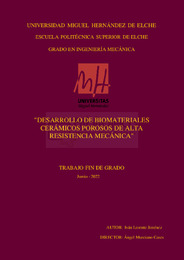Por favor, use este identificador para citar o enlazar este ítem:
https://hdl.handle.net/11000/32267Desarrollo de biomateriales cerámicos porosos de alta resistencia mecánica
| Título : Desarrollo de biomateriales cerámicos porosos de alta resistencia mecánica |
| Autor : Lorente Jiménez, Iván |
| Tutor: Murciano Cases, Ángel |
| Editor : Universidad Miguel Hernández de Elche |
| Departamento: Departamentos de la UMH::Ingeniería Mecánica y Energía |
| Fecha de publicación: 2022-06 |
| URI : https://hdl.handle.net/11000/32267 |
| Resumen : El envejecimiento de la población mundial ha provocado el incremento de afecciones relacionadas con la pérdida de hueso. Debido a este incremento, resulta necesario mejorar los métodos actuales de regeneración ósea, avanzando hacia la creación de sustitutos sintéticos del hueso. En este sentido, la investigación en ingeniería de tejidos, se centra en la creación de matrices tridimensionales porosas, las cuales se unen al hueso a reparar, promoviendo la proliferación y diferenciación de las células necesarias para su regeneración. Las cerámicas bioactivas resultan de gran interés para la creación de estas matrices, ya que son capaces de unirse al hueso a reparar, promoviendo su regeneración. Sin embargo, la bioactividad no es la única propiedad a tener en cuenta, la resistencia mecánica, entre otras, es una propiedad fundamental, necesaria para el correcto funcionamiento del implante. Conseguir buenas propiedades mecánicas y bioactividad resulta complicado, ya que, generalmente, son características antagónicas. Con el objetivo de obtener matrices con ambas propiedades, en el presente proyecto, se ha desarrollado una nueva metodología, la cual permite obtener matrices tridimensionales porosas de alta resistencia mecánica. Para ello, se ha utilizado la técnica sol-gel, formando un núcleo poroso de Wollastonita (CaSiO3), el cuál se recubre con fase vítrea perteneciente al sistema binario CaO-P2O5, obtenida también mediante técnica sol-gel. Esta estructura de alta resistencia mecánica presenta un exceso de fase vítrea, por lo que, para controlar este exceso, se vuelve a recubrir con Wollastonita, también con una fase vítrea de Boro. Con objeto de dotar a los núcleos obtenidos de bioactividad, se realiza un recubrimiento de Wollastonita dopada con iones Mg2+ y K+, obteniendo los núcleos finales. Los núcleos finales no mostraron bioactividad adecuada, debido a falta de control en el exceso de fase vítrea, por lo que se desarrolló un nuevo proceso capaz de eliminar este exceso, sumergiendo los núcleos en suero fisiológico artificial (SFA) durante 3 días. Una vez eliminado el exceso de fase vítrea, se obtuvieron núcleos de alta bioactividad, en los que sucede un proceso cíclico de precipitación y disolución de hidroxioapatito. Las muestras obtenidas a lo largo del proyecto se caracterizaron mediante Microscopía Electrónica de Barrido con Espectroscopía Dispersiva de Energía de Rayos X (SEM-EDX) y Difracción de Rayos X (DRX). Por último, se realizaron ensayos de bioactividad in vitro de los núcleos finales, realizando inmersiones en SFA. World population ageing has led to an increase in diseases related to bone loss. Because of this increase, it has been needed to create new synthetic bone substitutes, replacing actual bone regeneration methods. On this matter, tissue engineering research, focuses on the creation of highly porous 3D extracellular matrix or scaffold, that bonds to the bone, promoting bone regeneration. Bioactive ceramics have shown as the main candidates for bone regeneration, due to their good bioactivity properties and their biocompatibility. However, as well as bioactivity, these bone substitutes need to have other properties, such as mechanical strengh, among others. Having a mechanical performance similar to the bone one is essential, but, generally, bioactivity is antagonistic to mechanical strengh. In this project, it has been developed a new methodology, which allows the creation of highly porous scaffolds with high mechanical strengh. These scaffolds were created using sol-gel processing, by forming a wollastonite (CaSiO3) core, that was coated with a layer of CaO-P2O5 glass. Those scaffolds had an excess of glassy phase so, to control that excess, the high strengh scaffolds were coated with one of these phases: wollastonite or borate bioactive glass. Moreover, to improve their bioactivity, these scaffolds were coated with a layer of doped wollastonite, resulting in the final scaffolds. These final scaffolds were not bioactive, because of the excess of glassy phase, so, by soaking them in SBF for 3 days, that excees was removed, obtaining new bioactive scaffolds. The scaffolds obtained in this project have been studied using X-Ray Diffraction (XRD) and Scanning Electron Microscope fitted with Energy-Dispersive X-Ray Spectroscopy (SEM-EDX). Furthermore, the bioactivity of these scaffolds has been analyzed in vitro in simulated body fluid (SBF). |
| Palabras clave/Materias: regeneración ósea ingeniería de tejidos resistencia mecánica bioactividad difracción de Rayos X (DRX) bone regeneration tissue engineering mechanical strength bioactivity X-ray Diffraction (XRD) |
| Área de conocimiento : CDU: Ciencias aplicadas: Ingeniería. Tecnología |
| Tipo de documento : info:eu-repo/semantics/bachelorThesis |
| Derechos de acceso: info:eu-repo/semantics/openAccess Attribution-NonCommercial-NoDerivatives 4.0 Internacional |
| Aparece en las colecciones: TFG-Ingeniería Mecánica |
 La licencia se describe como: Atribución-NonComercial-NoDerivada 4.0 Internacional.
La licencia se describe como: Atribución-NonComercial-NoDerivada 4.0 Internacional.
.png)
